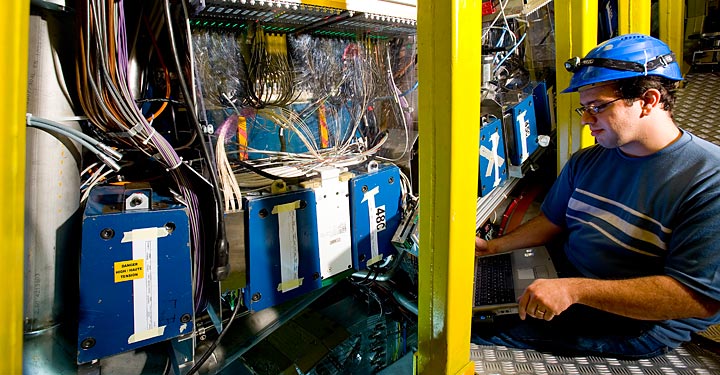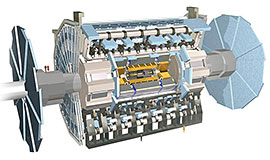ATLAS Calorimeter

Brookhaven physicist Denis Damazio controls the front end crate of the barrel liquid argon calorimeter in ATLAS with his laptop.
The ATLAS calorimeter measures the energies and positions of charged and neutral particles. It consists of metal plates (absorbers) and sensing elements. Interactions in the absorbers transform the energy into a "shower" of particles that are detected by the sensing elements.
In the inner sections of the calorimeter, the sensing element is liquid argon. This piece of the detector, called the liquid argon calorimeter, consists of radial layers of accordion-shaped lead plates separated by thin layers of liquid argon and electrodes. The accordion geometry maximizes the active volume of the detector and optimizes the transfer of the electrical signals to the readout electronics.
A cryostat surrounding the calorimeter maintains the argon in a liquid state at a temperature of –185 degrees Celsius (above which argon is a gas). When photons and electrons cross the lead plates, part of their energy is transformed into pairs of particles that spread out, thus revealing their presence. This shower creates an electric signal that is first collected on the electrodes. The signal is then transferred from the electrodes to the surrounding electronics through vacuum-sealed cylinders of cables in feedthroughs, specifically designed to preserve the properties of the signals while they make the transition from the cold liquid argon to the warm area where the electronics are located.
Before the electronic boards were installed in the calorimeter, a team of Brookhaven physicists, engineers, and technicians tested their response to electrical signals by immersing them in liquid nitrogen. (Liquid nitrogen simulates the cold temperature of liquid argon but is generally cheaper and more readily available.)
Another Brookhaven team assembled and tested the 64 feedthroughs of the calorimeter. The team tested the various parts of each feedthrough before assembling them and checked the quality of the connections, looking for possible leaks.
See also: Brookhaven contributions to the ATLAS muon spectrometer.



